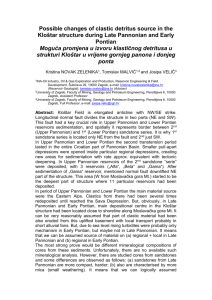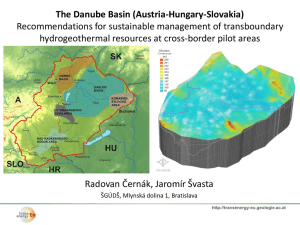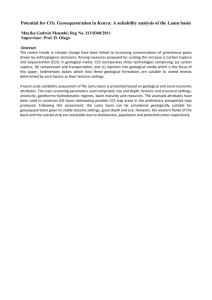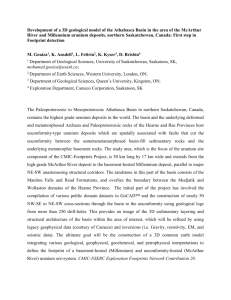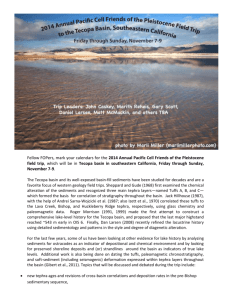Relation between time alteration of gravity field and vertical surface
advertisement
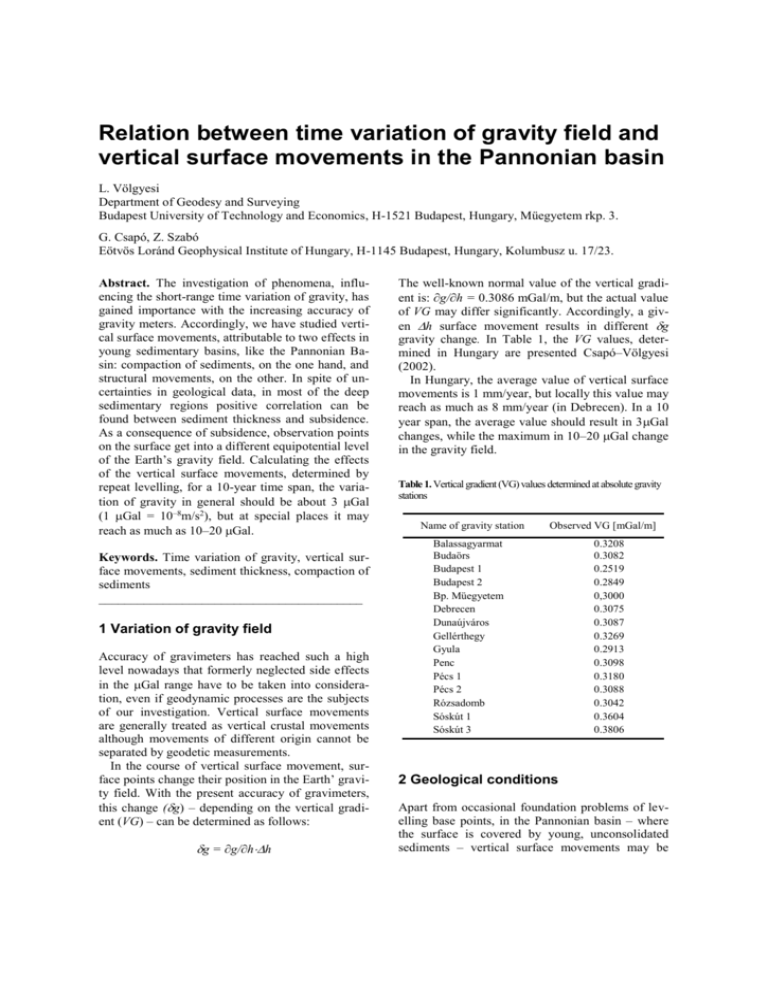
Relation between time variation of gravity field and vertical surface movements in the Pannonian basin L. Völgyesi Department of Geodesy and Surveying Budapest University of Technology and Economics, H-1521 Budapest, Hungary, Müegyetem rkp. 3. G. Csapó, Z. Szabó Eötvös Loránd Geophysical Institute of Hungary, H-1145 Budapest, Hungary, Kolumbusz u. 17/23. Abstract. The investigation of phenomena, influencing the short-range time variation of gravity, has gained importance with the increasing accuracy of gravity meters. Accordingly, we have studied vertical surface movements, attributable to two effects in young sedimentary basins, like the Pannonian Basin: compaction of sediments, on the one hand, and structural movements, on the other. In spite of uncertainties in geological data, in most of the deep sedimentary regions positive correlation can be found between sediment thickness and subsidence. As a consequence of subsidence, observation points on the surface get into a different equipotential level of the Earth’s gravity field. Calculating the effects of the vertical surface movements, determined by repeat levelling, for a 10-year time span, the variation of gravity in general should be about 3 Gal (1 Gal = 10–8m/s2), but at special places it may reach as much as 10–20 Gal. Keywords. Time variation of gravity, vertical surface movements, sediment thickness, compaction of sediments _________________________________________ 1 Variation of gravity field Accuracy of gravimeters has reached such a high level nowadays that formerly neglected side effects in the Gal range have to be taken into consideration, even if geodynamic processes are the subjects of our investigation. Vertical surface movements are generally treated as vertical crustal movements although movements of different origin cannot be separated by geodetic measurements. In the course of vertical surface movement, surface points change their position in the Earth’ gravity field. With the present accuracy of gravimeters, this change (g) – depending on the vertical gradient (VG) – can be determined as follows: g = g/hh The well-known normal value of the vertical gradient is: g/h = 0.3086 mGal/m, but the actual value of VG may differ significantly. Accordingly, a given h surface movement results in different g gravity change. In Table 1, the VG values, determined in Hungary are presented Csapó–Völgyesi (2002). In Hungary, the average value of vertical surface movements is 1 mm/year, but locally this value may reach as much as 8 mm/year (in Debrecen). In a 10 year span, the average value should result in 3Gal changes, while the maximum in 10–20 Gal change in the gravity field. Table 1. Vertical gradient (VG) values determined at absolute gravity stations Name of gravity station Observed VG [mGal/m] Balassagyarmat Budaörs Budapest 1 Budapest 2 Bp. Müegyetem Debrecen Dunaújváros Gellérthegy Gyula Penc Pécs 1 Pécs 2 Rózsadomb Sóskút 1 Sóskút 3 0.3208 0.3082 0.2519 0.2849 0,3000 0.3075 0.3087 0.3269 0.2913 0.3098 0.3180 0.3088 0.3042 0.3604 0.3806 2 Geological conditions Apart from occasional foundation problems of levelling base points, in the Pannonian basin – where the surface is covered by young, unconsolidated sediments – vertical surface movements may be attributed to two factors: compaction of sediments and structural movements. As 85 % of the area of Hungary belongs to the Pannonian basin, compaction of sediments (depending on their composition and thickness) influences significantly the levelling data. Therefore it is expedient to investigate the relations between sediments (their extension and thickness) and surface movement data. If compaction is determined and corrected for, crustal movements of geodynamic origin can be separated. Before dealing with compaction, a short review of basin evolution is given as revealed by geological and geophysical data. The Pannonian basin is the central part of the Carpathian basin, surrounded by the Alps, the Carpathians and the Dinarides. The Pannonian basin itself is divided into smaller sub-basins of different types by inselbergs, representing the basement on the surface. The largest of them is on its western part the Danube-Rába basin, shared by Hungary and Slovakia, while in the East the Great Hungarian Plain contains the Békés basin and the two deepest depressions, the Makó-Hódmezővásárhely and the Derecske troughs. Evolutions of the basins are in close connection with the emergence of the Alp-Carpathian system, consequently with the collision of the African and European plates. In the collision zone, microplates of different origin and in different stages of tectonization took up their present location during the Upper Cretaceous–Tertiary phase of the Alpian orogeny. The mantle diapir induced by the subducting plates resulted in thinning and subsidence of the crust. Apart from normal growth faults strike-slip faults played an important role in the evolution of the sub-basins, especially in the late phase of subsidence, leaving their mark even in the Pliocene sediments. Fig. 1 Distribution of Pannonian sediments in the Carpathian Basin, according to Carte Geologique Internationale dé l’Europe 1:1500 000 (1969). Both the time of initiation and the rate of subsidence of the different sub-basins may differ significantly. Palaeogene sediments are rare, mostly in the northern part of the Pannonian basin (in the so- called North-Hungarian Palaeogene basin). The subsidence of the whole basin started in the Neogene. At the beginning, the shallow- and subsequently deeper marine sediments onlap the base- ment. The filling-up process started with the enormous prograding delta system, originating from the emerging Carpathians and the separation of the Pannonian-sea from the Mediterranean, resulting in its becoming gradually a fresh-water lake. In the last phase of filling-up, the delta system was replaced by a more or less uniform lacustrine sedimentation. This tripartition of sedimentation agrees with the ratio of subsidence and sediment accumulation: in the beginning rate of sedimentation was less than subsidence, in the period of delta formation, especially in its earlier stages, subsidence and sediment accumulation are balanced, keeping the sea at a constant level, while in the last phase sedimentation rate exceeded subsidence, finishing the filling-up process. Lithology of the sedimentary fill depends on the sedimentation environment and on the source rocks, the rocks of the surrounding mountain chain. Deepwater sediments are fine-grained, undisturbed, locally of high carbonate content. Dipping layers of delta sediments represent transition from near-shore coarse sand toward fine-grained shale as receding from the actual coastline. This topic is dealt with the extensive literature of seismic stratigraphy; just mentioning a few Pogácsás (1980, 1984), Mattick et al. (1988). Comparing the above data of geophysical methods, based on physical parameters, and those of geological methods, studying lithological and palaeontological conditions, insoluble contradictions arise. A short review of the geological approach is given according to Jámbor (1985): The extension of the Pannonian sea changed in time, sometimes flooding even the Vienna- and Styrian basins in the West and the Transylvanian basin in the East (see Figure 1). Formations of the Pannonian sea, representing the 12–2.4 Ma interval – classified as Pannonian (s.l.), subdivided into Lower Pannonian, or Pannonian (s.str.) and Upper Pannonian, or Pontian, Dacian, Romanian, representing the Pliocene (5.4–2.4 Ma) – cover the whole basin area, except the mountains (see Figure 2). The Pannonian–Sarmatian contact can be traced easily along the mountain rims by lithology and palaeontology, but in the deep basins the identification of this contact is ambiguous, due to similar facies (fine-grained shale, marl). Accordingly, depth to base Pannonian data are burdened with significant errors. Fig. 2 Distribution of Pannonian sediments in Hungary according to (JÁMBOR 1979) 1 – Older than Pannonian formations on the surface (15%), 2 – Pannonian sediments on or close to the surface (28%), 3 – Pannonian below thick Pleistocene cover (57%). There are similar problems in the determination of the Pannonian–Pleistocene boundary. Near the coastlines Pleistocene deposits overlay Upper Pannonian by sharp discordance and they differ from Pannonian sediments both in grain-size and colour: Pleistocene sediments are represented by gravel and wind-blown sand. In the deep basins, however, sedimentation was continuous with similar facies: shale, aleurite, fine-grained sand. Determining the Upper Pannonian–Pleistocene contact, geologists have to use well-logging data, too. The generally accepted 2.4 Ma age was determined by palaeomagnetic investigations Rónai (1985). Thickness of overburden plays an important role in the character of the Pannonian sediments. In deep basins, Pannonian shales, marls are hard rocks; they keep their consistency if soaked, while the coarsegrained layers are sandstones and conglomerates. In near-surface conditions layers of similar composition and age appear as plastic clay and loose sand, gravel, respectively. Depth to base Pannonian varies significantly. During the 12 million years a difference of 5200 m developed between the Rudabánya Mts. and the Makó–Hódmezővásárhely trough, an equivalent of 0.4 mm/year average subsidence. At the end of the Pannonian, the Transdanubian Central Range tilted towards the south-east, accordingly its northwestern side had risen about 150–200 m, while its foreland, the Danube–Rába basin subsided significantly. The base Lower- and Upper-Pannonian, as well as thickness of Quaternary maps were constructed by the Geological Institute of Hungary (MÁFI), originally in the scale of 1:200,000 – in areas of detailed investigation in the scale of 1:25,000 – and published in the scale of 1:500,000 Csiky et al. 1986, Csiky (1987), Síkhegyi (1995). About the reliability of these maps Jámbor (1985) has written the following: “All available borehole data were used, although in the published map only a fraction of these holes are plotted, because of technical reasons. Constructing the isolines, for interpolating between boreholes the filtered gravity map of the National Petroleum Company (OKGT) and, at some places, their seismic data were utilized.” The majority of deep boreholes are oil- and gasexploration holes, with rare coring in the Pannonian sequence. For marking out geological horizons, well logging provided information. Naturally, in well logging curves, based on different physical parameters, those horizons can be identified unambiguously which represent sharp contrast between density, resistivity or velocity of under- and overlying rocks; the main such horizon being the basement. If Lower Pannonian sediments were deposited directly on the basement, that horizon is reliable, however, to decide whether older than Pannonian sediments occur or not, is very difficult, even if the borehole has penetrated deep enough. The Lowerand Upper Pannonian, as well as the Upper Pannonian and Quaternary contacts carry even more ambiguity. The distribution of oil-exploration deep boreholes is extremely disproportionate, comparing the infield and between fields borehole spacing. Interpolation by gravity data is only justified in the case of the base Pannonian horizon, and within areas of similar geological build-up. Seismic reflections can be correlated with geological horizons but their reliability depends on their age, i.e. on the applied technique. Fig. 3 Location map of levelling profiles with direction of sampling Profile 4 500 1 0 0.5 Profile 8 500 2 0 1.5 -500 0 -1000 -500 -0.5 -1000 -1 -1500 -1.5 -2000 -2 -2500 -2.5 -3000 1 -1500 -2000 -2500 Quaternary Up.Pannonian Lo.Pannonian v [mm/year] -3000 -3500 -3 180 195 -4000 0 20 120 100 80 60 40 140 160 Profile 13 1000 0 500 -0.5 0 -1 -500 -1.5 -1000 0.5 Quaternary Up.Pannonian Lo.Pannonian v [mm/year] -3500 0 15 30 45 60 75 90 105 0 120 135 150 165 -0.5 180 Profile 14 0 0 -500 -0.5 -1000 -1 -1500 -1.5 -2000 -2 -2 -1500 -2.5 -2000 -2500 Quaternary Up.Pannonian -3 Lo.Pannonian -3.5 v [mm/year] -3000 -3500 0 15 30 45 60 75 90 105 -4 -4.5 -4000 -1000 -1 -3.5 v [mm/year] -4 0 -0.5 -3 Lo.Pannonian -3500 0 -2.5 Quaternary Up.Pannonian -3000 120 Profile15 0 -2500 10 20 30 40 50 60 70 Profile16 0 0 -500 -0.5 -1000 -1 -1.5 -2000 -1500 -1.5 -2.5 -2000 -2 -3 -2500 -2 -3000 Quaternary -4000 -5000 Up.Pannonian -3.5 Lo.Pannonian -4 v [mm/year] -4.5 -6000 0 15 30 45 60 75 90 105 -4000 0 0 -1 -200 Quaternary -3 Up.Pannonian Lo.Pannonian -3500 -5 120 Profile 19 0 -2.5 Quaternary -3000 -3.5 v [mm/year] 0 15 30 45 60 75 90 -4 105 Profile 22 0 -200 -0.5 -2 -400 Up.Pannonian -600 Lo.Pannonian -3 v [mm/year] -4 -400 -1 -600 -800 -5 -1000 -6 -1200 -800 -1.5 -1000 Quaternary Up.Pannonian Lo.Pannonian v [mm/year] -7 -1400 -8 -1600 -9 0 5 10 15 20 25 30 35 40 -1200 -2 -1400 -2.5 0 10 20 30 40 50 Fig. 4 Sediment thickness and velocity of vertical surface movement along levelling lines 4, 8, 13, 14, 15, 16, 19, 22. Depths to 1 – base Qaternary, 2 – base Upper Pannonian, 3 – base Lower Pannonian. 4 – velocity of vertical surface movement 60 Concluding the above-written aspects, it is obvious that geological data are burdened by heavy ambiguities. On the other hand, the average least square error of vertical surface movement is 0.97 mm/year Joó (1996). In our investigation, to decrease ambiguities as much as possible, the following method was used: Starting out from the surface movement map Joó (1995), data were sampled at a 5 km rate along the levelling lines. This method was chosen to avoid the interpolation errors introduced by using geological data in map construction. Thus our data set can be regarded reliable and independent from any geological considerations. Location map of levelling lines is given in Figure 3. Next, the depths data of the following geological horizons were determined in the sampling points: base Pannonian, Lower- and Upper Pannonian contact and base Quaternary. This latter was deduced from the Quaternary thickness map, as the few metres thickness of the Holocene can be neglected, compared to other possible errors. These data were plotted for 24 levelling lines (in lines 23 and 25 no useful sediment data were found), and a few interesting examples were presented in Figure 4. Numbering of these graphs corresponds to that of the levelling lines in Figure 3, where even the directions of the profiles are also given. On the horizontal axis the distance from the starting point is given in km, on the vertical axes, on the left side the depths data of the geological horizons in m, while on the right side the vertical surface movement data are given in mm/year. 3. Conclusions It can be seen in these graphs, that in spite of all uncertainty, positive correlation exists between sediment thickness and surface movement. Preliminary correlation computations show significant differences in the degree of correlation between sub-basins, the highest deviation was found in the Zala basin, with negative correlation. Accordingly, no uniform correlation can be expected for the whole area of the Pannonian basin between sediment thickness and surface movement, or between sediment thickness and gravity variation, respectively. With regard to the type and tectonic conditions of each sub-basin, those sections of the levelling lines should be collected for further correlation computations where these parameters are similar. We are continuing our investigation in this direction. Acknowledgement We should thank for the funding of the above investigations to the National Scientific Research Fund (OTKA T-037929), and for the assistance provided by the Physical Geodesy and Geodynamic Research Group of the Hungarian Academy of Sciences. References Csapó G., Völgyesi L. 2002: Determination and reliability of vertical gradients (VG) based on test measurements in Hungary (in Hungarian with English abstract). Magyar Geofizika 43, 4. pp. 151–160 Csiky G. et al. 1986: Pannonian formations of Hungary. Map of base Transdanubian Super-group (Upper Pannonian). M=1:500,000. Geol. Inst. of Hungary Csiky G. ed. 1987: Map of base Peremarton Super-group (Lower Pannonian). M=1:500,000. Geol. Inst. of Hungary Jámbor Á. 1985: Explanatory notes to the geological maps of Pannonian Formations of Hungary, M=1:500,000. Geol. Inst. of Hungary Joó I. ed. 1995: The National Map of vertical movements of Hungary (M=1:1,000,000) Joó I. 1996: Vertical movements of the Earth’s surface in Hungary. Geodézia és Kartográfia XLVIII. 4. pp. 6–12 Mattick R. E., Rumpler J., Phillips R. L. 1985: Seismic stratigraphy and depositional framework of sedimentary rocks in the Pannonian Basin in southeastern Hungary. AAPG Memoir 45. pp. 117-146 Pogácsás Gy. 1980: Evolution of Hungary’s Neogene depressions in the light of geophysical surface measurements (in Hungarian with English abstract). Földtani Közlöny 110. 3–4. pp.485–497 Pogácsás Gy. 1984: Seismic stratigraphic features of Neogene sediments in the Pannonian Basin. Geophysical Transactions 30. 4. pp. 373–410 Rónai A. 1985: The Quaternary of the Great Hungarian Plain. Geol. Hung. Ser. Geol. Vol. 21. 446 p. Síkhegyi F. 1995 after Franyó 1992: The thickness of the Quaternary sediments in Hungary, M=1:500,000. Geol. Inst. of Hungary *** Völgyesi L, Szabó Z, Csapó G (2004): Relation between time variation of gravity field and vertical surface movements in the Pannonian basin. IAG International Symposium, Gravity, Geoid and Space Missions. Porto, Portugal August 30 - September 3, 2004. Dr. Lajos VÖLGYESI, Department of Geodesy and Surveying, Budapest University of Technology and Economics, H-1521 Budapest, Hungary, Műegyetem rkp. 3. Web: http://sci.fgt.bme.hu/volgyesi E-mail: volgyesi@eik.bme.hu
